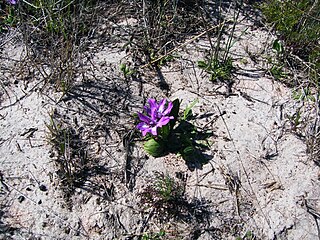
Sparaxis is a genus of flowering plants called the harlequin flowers. It belongs to the iris family Iridaceae with about 13 species endemic to Cape Province, South Africa.

Freesia is a genus of herbaceous perennial flowering plants in the family Iridaceae, first described as a genus in 1866 by Christian Friedrich Ecklon (1886) and named after the German botanist and medical practitioner, Friedrich Freese (1795-1876). It is native to the eastern side of southern Africa, from Kenya south to South Africa, most species being found in Cape Provinces. Species of the former genus Anomatheca are now included in Freesia. The plants commonly known as "freesias", with fragrant funnel-shaped flowers, are cultivated hybrids of a number of Freesia species. Some other species are also grown as ornamental plants.

Iridaceae is a family of plants in order Asparagales, taking its name from the irises, meaning rainbow, referring to its many colours. There are 66 accepted genera with a total of c. 2244 species worldwide. It includes a number of other well known cultivated plants, such as freesias, gladioli and crocuses.

Crocosmia (;), montbretia, is a small genus of flowering plants in the iris family, Iridaceae. It is native to the grasslands of southern and eastern Africa, ranging from South Africa to Sudan. One species is endemic to Madagascar.

Dietes is a genus of rhizomatous plants of the family Iridaceae, first described as a genus in 1866. Common names include wood iris, fortnight lily, African iris, Japanese iris and butterfly iris, each of which may be used differently in different regions for one or more of the six species within the genus.

Chasmanthe is a genus of flowering plants in the family Iridaceae, first described in 1932. It is endemic to Cape Province in South Africa. It is widely grown as an ornamental and naturalized in various locations.

Ferraria is a genus of monocotyledonous flowering plants in the family Iridaceae, native to tropical and southern Africa. They are herbaceous corm-bearing plants growing to 30–45 cm tall. Some species have an unpleasant scent similar to rotting meat and are pollinated by flies, while others have a pleasant scent. The genus name is a tribute to Italian Jesuit Botanist and botanical artist Giovanni Baptista Ferrari.

Tritonia is a genus of flowering plants in the iris family first described as a genus in 1802. They are naturally distributed across southern Africa, with a high concentration of species in Cape Province of western South Africa. The genus is closely related to the genus Ixia.

Aristea is a genus of evergreen, perennial and rhizomatous species of flowering plants in the family Iridaceae, first described in 1789. The genus is distributed in tropical and southern Africa, as well as Madagascar. The genus name is derived from the Greek word arista, meaning "awn".
Devia is a genus of plants in the family Iridaceae first described in 1990. It contains only one known species, Devia xeromorpha, endemic to the southwestern part of Cape Province in South Africa. The genus was named in honour of the South African botanist and academic, Miriam Phoebe de Vos.

Melasphaerula is a genus of flowering plants in the family Iridaceae, first described as a genus in 1803. There is only one known species, Melasphaerula graminea, native to Namibia and the Cape Province in South Africa.

Micranthus is a genus of flowering plants in the family Iridaceae. The entire genus is endemic to Cape Province in South Africa.

Nivenia is a genus of flowering plants in the family Iridaceae first described as a genus in 1808. Species in the genus are restricted in distribution to an area in the Cape Province of South Africa.
Pillansia is a genus of flowering plants in the family Iridaceae, first described as a genus in 1914. It contains only one known species, Pillansia templemannii, endemic to Cape Province in South Africa.
Thereianthus is a genus of flowering plants in the family Iridaceae, first described as a genus in 1941. The entire genus is endemic to Cape Province in South Africa.

Tritoniopsis is a genus of flowering plants in the family Iridaceae, first described as a genus in 1926. The entire genus is endemic to Cape Province in South Africa. The genus name refers to the African genus Tritonia and is combined with the Greek word opsis, meaning "look-alike".

Babiana ambigua is a species of plant in the Iridaceae. It is endemic to Cape Province in South Africa.

Babiana nana, the sandflat baboon-root, is a species of plants in the family Iridaceae. It is endemic to Cape Province of South Africa, and naturalized in Western Australia.
- Babiana nana subsp. maculata(Klatt) Goldblatt & J.C.Manning
- Babiana nana subsp. nana
Peter Goldblatt is a South African botanist, working principally in the United States.

Nivenioideae is a subfamily of flowering plants and one of the six subfamilies in the family Iridaceae. It contains three genera, from South Africa which are the only true shrubs in the family, It previously included Aristea, Patersonia and also Geosiris, which are now each placed in their own monotypic subfamily.
















